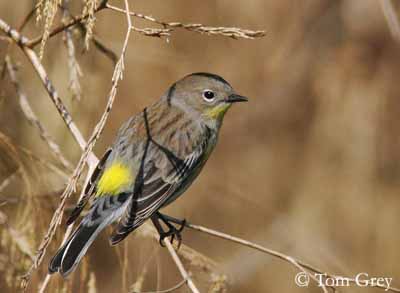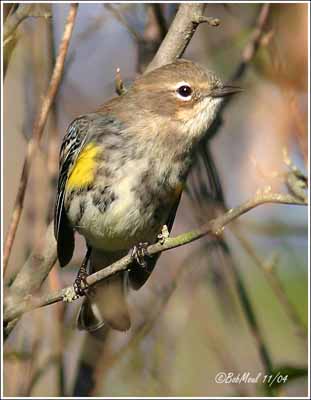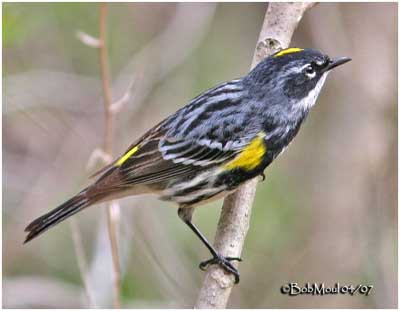
Yellow-rumped Warbler or Myrtle warbler
Setophaga coronata
Passeriforme Order – Parulidae Family
BIOMETRICS:
Length: 12-14 cm
Wingspan: 19-23 cm
Weight: 12-13 g
LONGIVITY: Up to 6 years
DESCRIPTION:
Yellow-Rumped Warbler is a small songbird.
In all plumages, it has whitish underparts with dark streaking, but Myrtle race has white or whitish throat strongly contrasting bright yellow rump and patch on sides of breast. It has usually a small yellow patch at centre of crown, boldly streaked blue-grey or grey-brown upperparts, and double white wing bars. It has white tail spots near tips.
In summer plumage, the male is streaked on underparts forming blackish breast band.
PROTECTION / THREATS / STATUS:
Yellow-Rumped Warbler is probably the most abundant of all warblers’ species. Populations are rising at around 2% per year, in the last 25 years.
Fr: Paruline à croupion jaune
All : Kronwaldsänger
Esp: Chipe Coronado
Ital: Dendroica groppone giallo
Nd: Geelstuitzanger
Russe: Миртовый певун
Sd: Gulgumpad skogssångare
Photographs by Bob Moul – Race Myrtle
His website:
Nature Photography
Photographs by Tom Grey – Race Audubon’s
His website: Tom Grey's Bird Pictures
Texte de Nicole Bouglouan
Sources:
A GUIDE TO THE BIRDS OF MEXICO AND NORTHERN CENTRAL AMERICA by Steve N. G. Howell, Sophie Webb - Oxford University Press - ISBN: 0198540124
BIRDS OF THE GREAT BASIN – by Fred A. Ryser - Univ of Nevada Pr -ISBN: 0874170796
FIELD GUIDE TO THE BIRDS OF NORTH AMERICA by National Geographic Society - National Geographic Society - ISBN: 0792274512
All About Birds (Cornell Lab of Ornithology)
Animal Diversity Web (University of Michigan Museum of Zoology)
Bird Web (Seattle Audubon Society)
What Bird-The ultimate Bird Guide (Mitchell Waite)
Wikipedia (Wikipedia, The Free Encyclopedia)

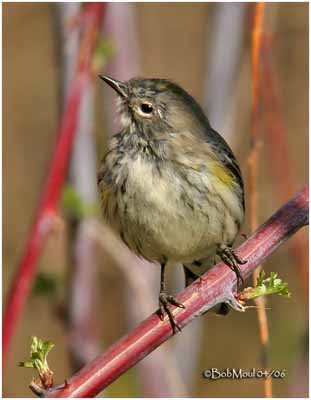
Juvenile is grey and extensively streaked, with rump dull white streaked with dark, not yellow.
In first winter, yellow patches on crown and sides of breast are reduced, or even absent.
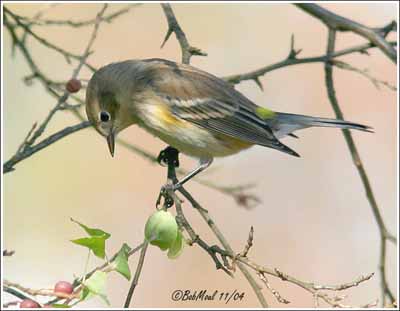
In adult female also, the crown patch is much reduced. She is duller than male and without black markings.
Rather long-tailed, Yellow-Rumped Warbler has a shorter bill than most other Dendroica species. It has white crescents above and below eye. Legs and feet are dark.
The throat is white in the widespread “Myrtle” form, and yellow in the western “Audubon’s” form.

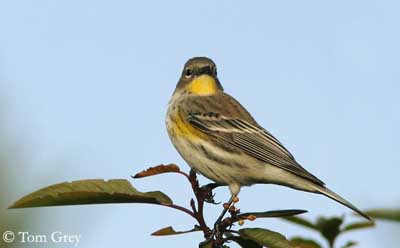
VOICE: SOUNDS BY XENO-CANTO
Yellow-Rumped Warbler’s calls include a loud, hard, rather metallic “chek” or “tick”, and a thin “tsi”. Song is a slow and clear ‘tuwee-tuwee-tuwee-tuwee”, often changing in pitch towards end, usually rising or falling at the end. It must often sing from the high canopy of trees.
HABITAT:
Yellow-Rumped Warbler breeds in open coniferous and mixed woodlands. It winters in open areas, along woodlands edges, second growth, dunes, marshes and residential areas.
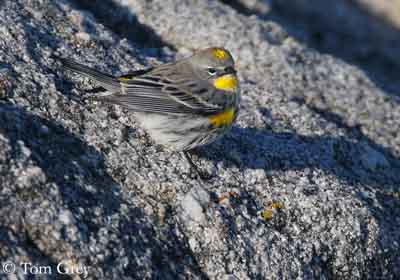
RANGE:
Audubon’s Warbler lives in the West, and “Myrtle” Warbler in the East. Yellow-Rumped Warbler breeds from Alaska and Canada, southward to the northern United States and southward through Mexico to Guatemala. It winters primarily along the Atlantic and Gulf coasts, also locally in interior eastern United States, along the Pacific coast on the US, and in Mexico, Caribbean and Central America.
BEHAVIOUR:
Yellow-Rumped Warbler is a facultative migrant. It moves with food availability and weather. It forages lower than many species, happily feeding in low weedy vegetation, or hopping on ground, but equally at home among foliage of bushes and trees. It can catch prey in flight. They hawk for insects by darting from branches.
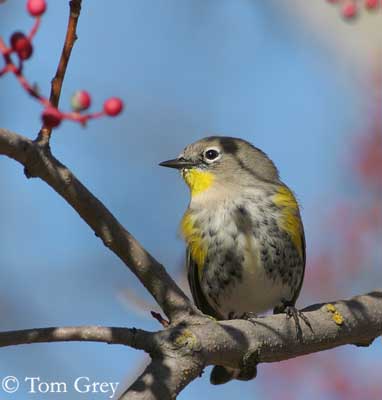
Yellow-Rumped Warbler is able to digest the waxes found in bay berries and wax myrtles. Its ability to use these fruit allows it to winter farther north than other warblers, sometimes as far north as Newfoundland. (Wax myrtles are the main source of wax used in making candles).
In winter and migrations, Yellow-Rumped Warblers are found foraging in flocks with their own species. These flocks may be quite large. During winter, they disperse in loose flocks, chirping a “contact call” that keeps the flock together.
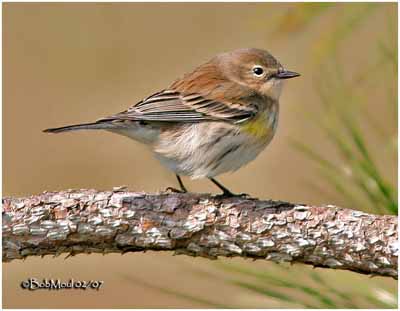
FLIGHT:
Yellow-Rumped Warbler travels in small flocks. It appears to be in constant motion, often flittering from branch to branch.
REPRODUCTION:
Yellow-Rumped Warbler is monogamous. The female builds the nest which is a neat cup of twigs, bark strips, rootlets, and lined with grasses, hair and feathers. It is placed on horizontal branch near the trunk of a conifer tree at about six metres high.
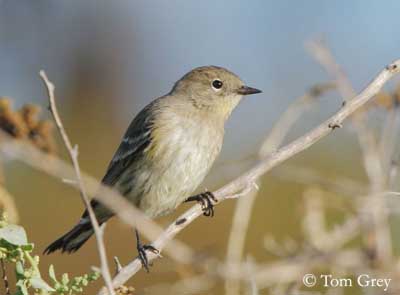
Female lays 4 to 5 cream-coloured eggs with brown spots. Incubation lasts 12 to 13 days by female. Male feeds the female at nest, and occasionally, helps incubate. Chicks hatch helpless with sparse down. Both parents feed the young. They fledge 12 to 14 days after hatching. They can make short flights within a few days of leaving the nest.
Once the young fledge, female often starts a second brood, while the male continues to feed the first brood for up to two weeks.
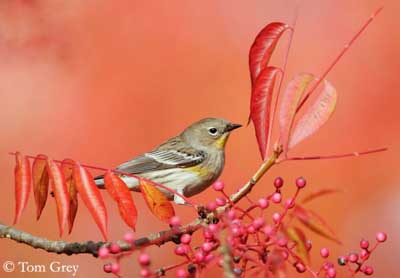
DIET:
Yellow-Rumped Warbler feeds mainly on insects in summer, and on bay berries (Laurus nobilis) and wax myrtles (Myrica cerifera), and other fruit in winter.
